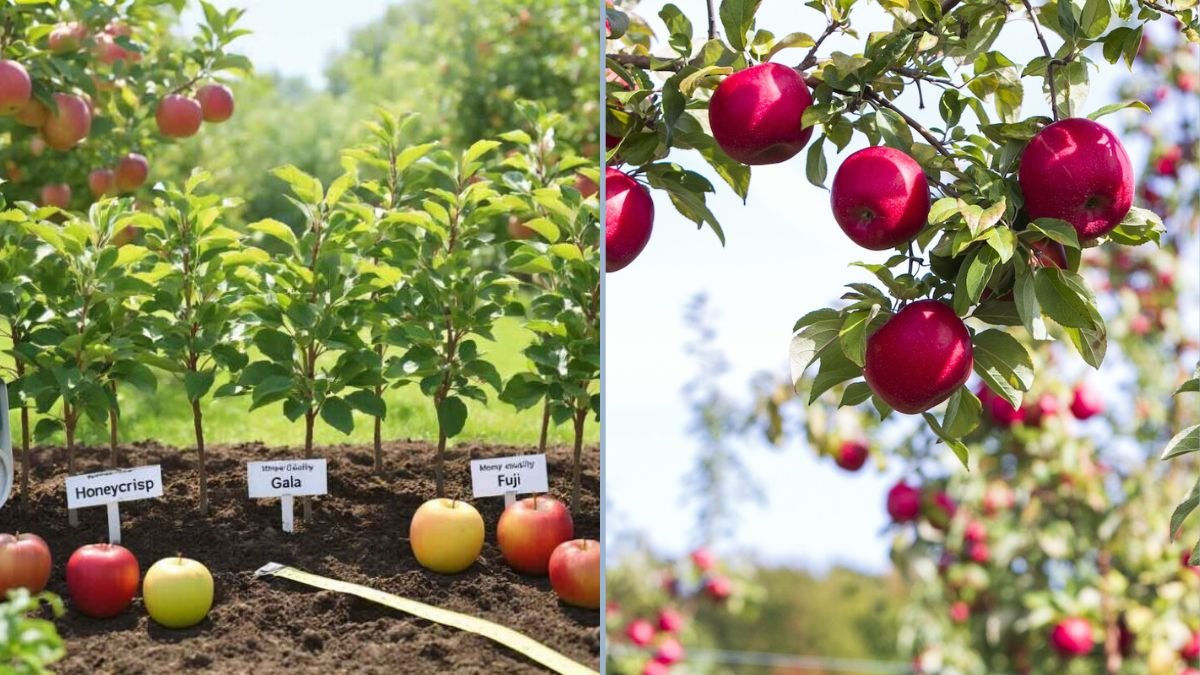There’s something magical about stepping into your own backyard orchard and picking crisp, juicy apples straight from the tree. Even in suburban areas with limited space, it’s entirely possible to cultivate a variety of apple trees that produce a bountiful harvest while enhancing your garden’s beauty.
In this guide, we’ll explore how to create a suburban apple orchard featuring three popular varieties: Honeycrisp, Fireside, and McIntosh apples. We’ll cover tree selection, planting, care, pruning, pest management, and harvesting to help you establish a thriving orchard right outside your door.
Why Start a Suburban Apple Orchard?
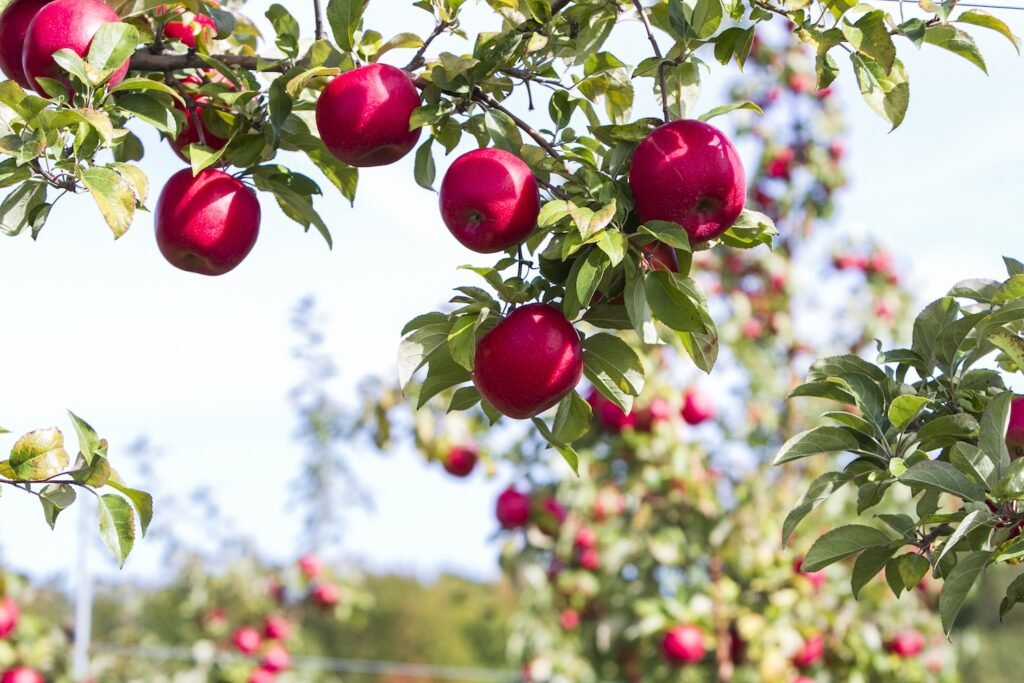
Even small spaces can support multiple apple trees, offering numerous benefits:
- Freshness: Enjoy apples at peak ripeness, far superior to store-bought produce.
- Variety: Plant different apple varieties to enjoy a range of flavors and textures.
- Health and Sustainability: Grow your apples organically, reducing pesticide use.
- Aesthetics: Apple trees produce beautiful blossoms in spring and colorful fruit in fall.
- Educational Opportunities: Teach children about plant growth, pollination, and fruit production.
A suburban orchard doesn’t just provide fruit—it adds a sense of calm, beauty, and connection to nature to your home environment.
Choosing Apple Varieties for Your Orchard
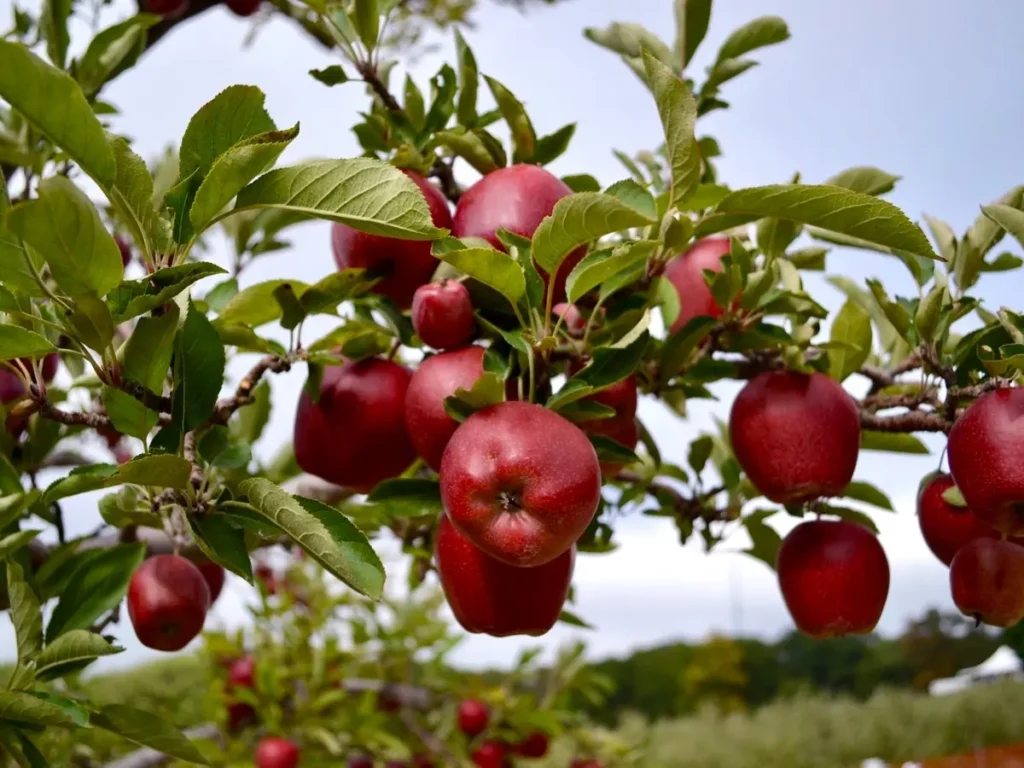
1. Honeycrisp Apples
- Flavor: Exceptionally sweet, crisp, and juicy.
- Ripening: Late September to early October.
- Benefits: Early bearers, disease-resistant, excellent for fresh eating.
- Growing Notes: Thrives in full sun and well-drained soil. Requires cross-pollination with another variety such as McIntosh or Fireside for best yields.
2. Fireside Apples
- Flavor: Sweet-tart with a firm texture, perfect for baking and fresh eating.
- Ripening: Early to mid-October.
- Benefits: Compact growth habit, suitable for smaller suburban spaces.
- Growing Notes: Disease-resistant and adaptable to container or in-ground planting.
3. McIntosh Apples
- Flavor: Tender, juicy, slightly tart, ideal for sauces and pies.
- Ripening: Late September.
- Benefits: Classic apple variety, excellent for cider-making and culinary use.
- Growing Notes: Prefers cooler climates, good disease resistance, and compatible with Honeycrisp and Fireside for pollination.
By selecting a combination of these three varieties, you ensure a staggered harvest and a diverse range of flavors throughout the fall season.
Planning Your Suburban Orchard
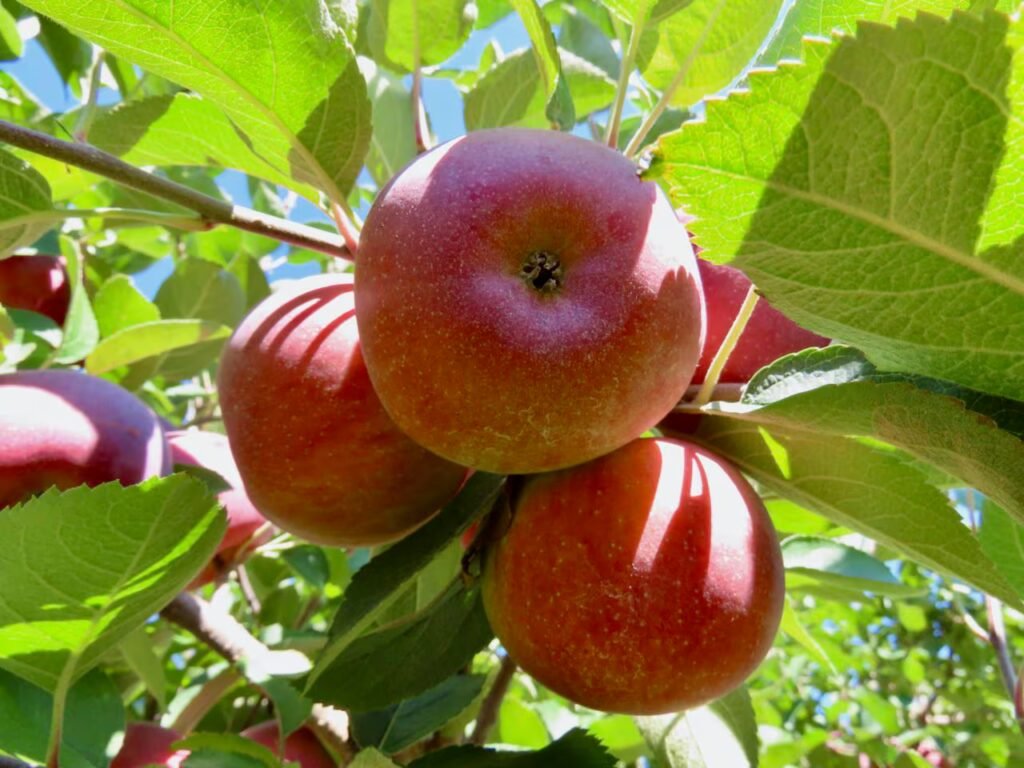
Before planting, consider these key factors:
1. Sunlight
- Apple trees require at least 6–8 hours of direct sunlight daily.
- Adequate sunlight ensures optimal fruit sweetness, color, and tree health.
2. Soil
- Well-draining, loamy soil is ideal.
- Soil pH: 6.0–7.0.
- Amend with compost or well-rotted manure to improve fertility.
3. Spacing
- Standard apple trees: 18–25 feet apart.
- Semi-dwarf trees: 12–15 feet apart.
- Dwarf trees: 8–10 feet apart.
Proper spacing promotes sunlight penetration, airflow, and ease of pruning and harvesting.
4. Pollination
- Most apple trees require cross-pollination to produce fruit.
- Ensure compatible varieties are nearby to encourage bee activity and fruit set.
Planting Your Apple Trees
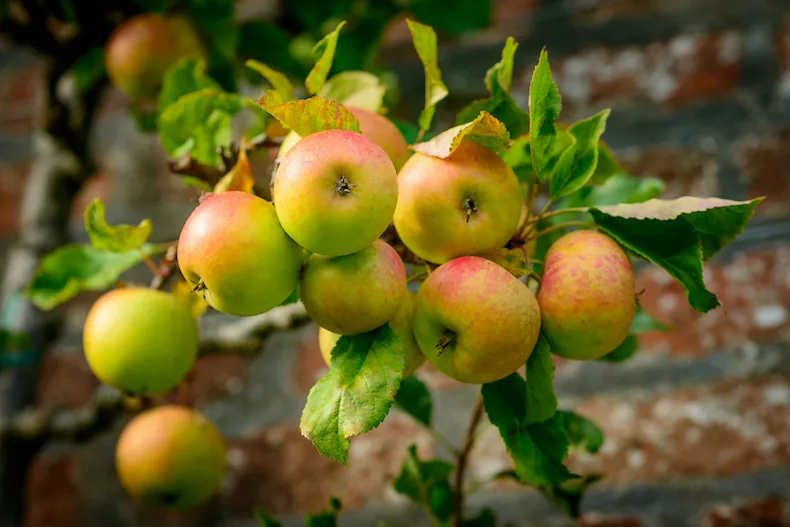
Proper planting sets the foundation for long-term orchard health.
Step 1: Digging the Hole
- Dig a hole twice the width of the root ball and slightly deeper than the roots.
- Loosen soil at the bottom to encourage root expansion.
Step 2: Positioning the Tree
- Place the tree in the hole with the graft union slightly above soil level.
- Spread roots evenly and backfill with soil mixed with compost.
- Firm gently to eliminate air pockets.
Step 3: Watering and Mulching
- Water thoroughly to settle the roots.
- Apply 2–3 inches of mulch around the base to retain moisture and suppress weeds.
- Keep mulch a few inches away from the trunk to prevent rot.
Step 4: Staking
- Young trees may need staking for stability, especially in windy areas.
- Remove stakes after one growing season when the trunk has strengthened.
Caring for Your Apple Orchard
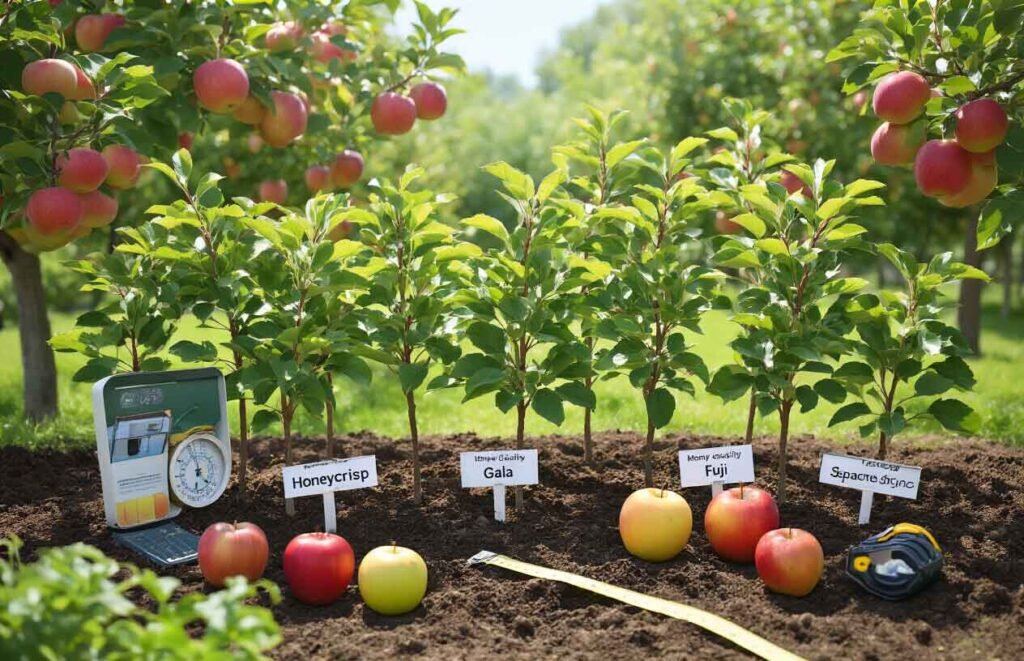
1. Watering
- Young trees: Water 2–3 times per week to establish roots.
- Mature trees: Deep watering once a week, more frequently in dry periods.
- Mulching helps maintain moisture and regulate soil temperature.
2. Fertilizing
- First-year trees: Light fertilization for root development.
- Second year onward: Apply a balanced fertilizer (10–10–10 NPK) in early spring.
- Avoid over-fertilization, which can encourage leaf growth at the expense of fruiting.
3. Pruning
Pruning maintains tree shape, improves airflow, and promotes fruit production.
Dormant Pruning
- Conduct in late winter before buds break.
- Remove dead, diseased, or crossing branches.
- Maintain a central leader or open-center structure depending on tree type.
Summer Pruning
- Optional light pruning removes vigorous shoots.
- Helps direct the tree’s energy toward fruit production.
Pollination and Flowering
- Apple trees bloom in spring, producing attractive white or pink blossoms.
- Planting compatible varieties nearby encourages cross-pollination.
- Bees are critical for fertilization—avoid spraying pesticides during bloom.
Proper pollination ensures larger, sweeter apples and consistent yields across your orchard.
Pest and Disease Management
Even suburban orchards need regular monitoring.
Common Pests
- Aphids
- Codling moth
- Spider mites
Common Diseases
- Apple scab
- Powdery mildew
- Fire blight
Prevention Tips:
- Prune trees for proper airflow and sunlight penetration.
- Remove fallen leaves and fruit to reduce fungal buildup.
- Use organic sprays like neem oil when necessary.
Thinning Fruit for Better Quality
- Thin fruit clusters to 1–2 apples per cluster.
- Prevents branch stress and encourages larger, sweeter apples.
- Ensures sunlight reaches all fruit for uniform ripening.
Harvesting Honeycrisp, Fireside & McIntosh Apples
- Honeycrisp: Late September to early October.
- Fireside: Early to mid-October.
- McIntosh: Late September.
Signs of readiness:
- Firm, crisp texture
- Full color and slight sheen
- Sweet-tart aroma
- Easy detachment from the branch
- Harvest carefully using scissors or gentle twisting to avoid damaging branches.
- Enjoy fresh, bake, or store in a cool location for extended freshness.
Container Growing in a Suburban Setting
- Dwarf and semi-dwarf trees thrive in large containers, perfect for patios or terraces.
- Use pots 18–24 inches in diameter with drainage holes.
- Fill with nutrient-rich potting mix and compost.
- Water regularly, as containers dry out faster than in-ground trees.
- Prune to maintain size and encourage fruiting.
Additional Tips for a Thriving Orchard
- Monitor Growth: Check for pests, diseases, and nutrient deficiencies.
- Mulch Annually: Helps conserve moisture and regulate soil temperature.
- Support Young Trees: Stake for stability.
- Practice Patience: Apple trees may take 2–4 years to produce fruit.
- Enjoy the Process: Gardening is a journey, and your orchard will reward care and attention with delicious harvests.
Conclusion
Creating a suburban apple orchard with Honeycrisp, Fireside, and McIntosh apples is both practical and rewarding. By carefully selecting varieties, preparing the planting site, providing proper care, and monitoring for pests and diseases, you can enjoy fresh, homegrown apples throughout the fall.
Even small suburban spaces can host a thriving orchard. With attention, patience, and consistent care, your backyard will become a haven of beauty and flavor, offering crisp, juicy apples for years to come. Whether eaten fresh, baked into pies, or made into cider, these apples bring the taste of an orchard right to your home.
